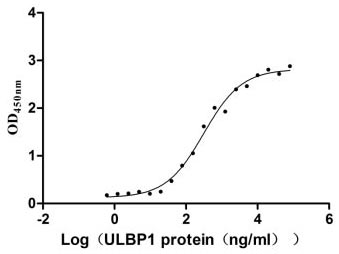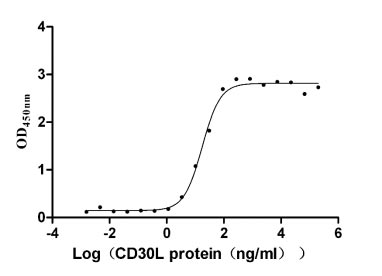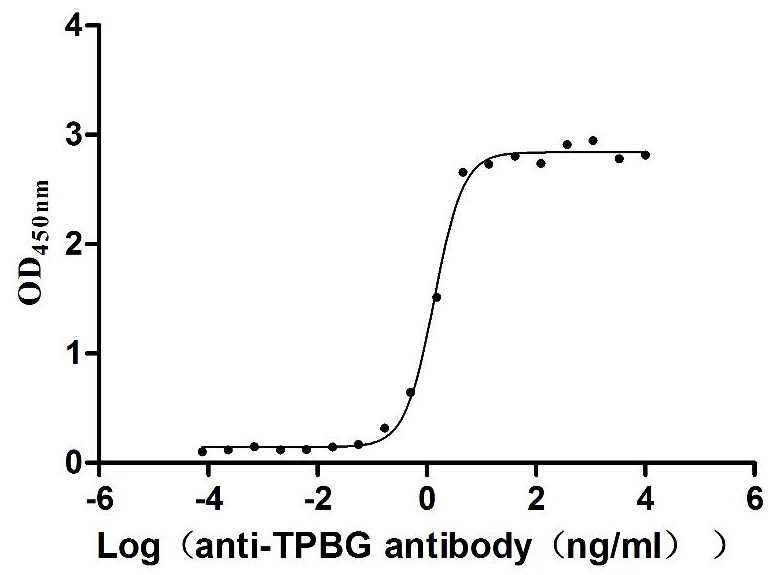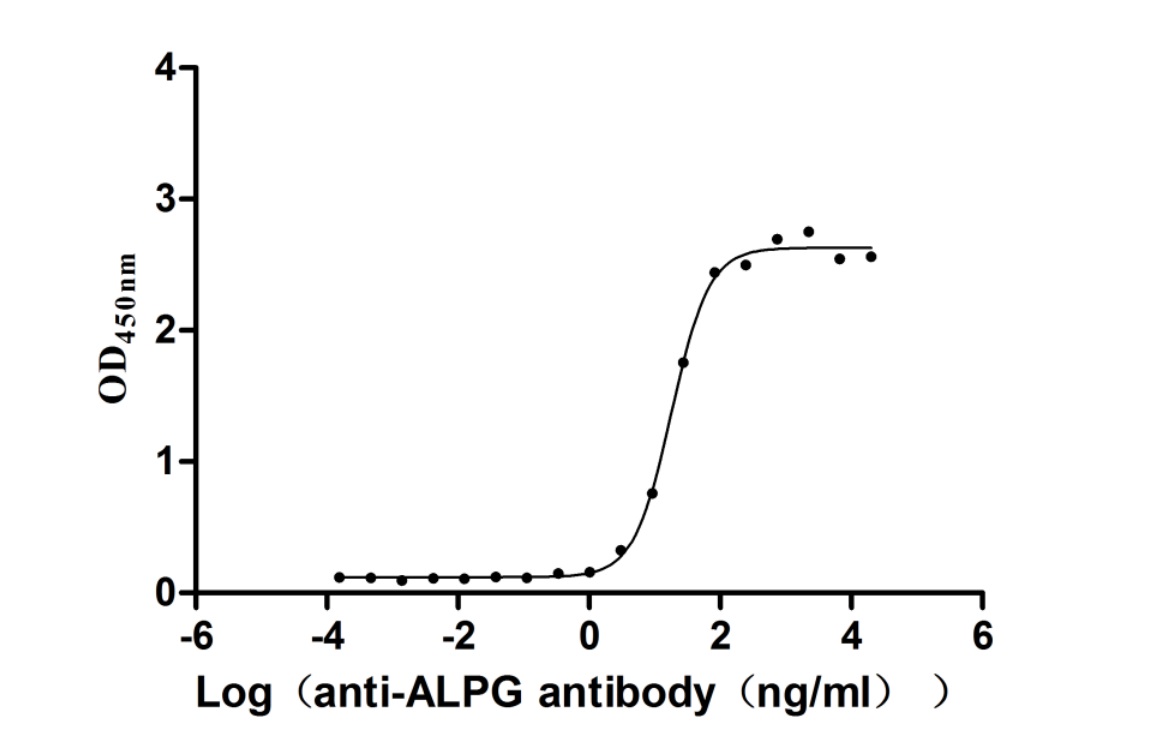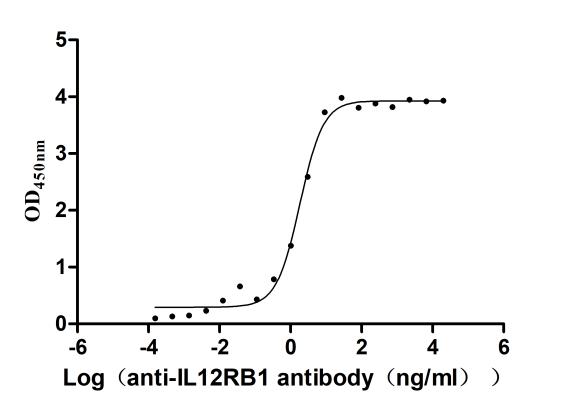Recombinant Human Macrophage-stimulating protein receptor (MST1R), partial
-
中文名称:人MST1R重组蛋白
-
货号:CSB-YP015056HU
-
规格:
-
来源:Yeast
-
其他:
-
中文名称:人MST1R重组蛋白
-
货号:CSB-EP015056HU
-
规格:
-
来源:E.coli
-
其他:
-
中文名称:人MST1R重组蛋白
-
货号:CSB-EP015056HU-B
-
规格:
-
来源:E.coli
-
共轭:Avi-tag Biotinylated
E. coli biotin ligase (BirA) is highly specific in covalently attaching biotin to the 15 amino acid AviTag peptide. This recombinant protein was biotinylated in vivo by AviTag-BirA technology, which method is BriA catalyzes amide linkage between the biotin and the specific lysine of the AviTag.
-
其他:
-
中文名称:人MST1R重组蛋白
-
货号:CSB-BP015056HU
-
规格:
-
来源:Baculovirus
-
其他:
-
中文名称:人MST1R重组蛋白
-
货号:CSB-MP015056HU
-
规格:
-
来源:Mammalian cell
-
其他:
产品详情
-
纯度:>85% (SDS-PAGE)
-
基因名:
-
Uniprot No.:
-
别名:c met related tyrosine kinase; CD136; CD136 antigen; CDw136; Macrophage stimulating 1 receptor (c met related tyrosine kinase); Macrophage stimulating 1 receptor; Macrophage stimulating protein receptor alpha chain; MACROPHAGE STIMULATING PROTEIN RECEPTOR; Macrophage stimulating protein receptor beta chain; Macrophage-Stimulating 1 Receptor (MST1R); Macrophage-stimulating protein receptor beta chain; MSP receptor; Mst1r; MST1R variant RON30; MST1R variant RON62; NPCA3; p185 RON; p185-Ron; Protein-tyrosine kinase 8; PTK 8; ptk8; PTK8 protein tyrosine kinase 8; Recepteur d鈥檕rigine nantais (RON); RON; RON protein tyrosine kinase; RON variant E2E3; RON_HUMAN; Soluble RON variant 1; Soluble RON variant 2; Soluble RON variant 3; Soluble RON variant 4; Stem cell derived tyrosine kinase
-
种属:Homo sapiens (Human)
-
蛋白长度:Partial
-
蛋白标签:Tag type will be determined during the manufacturing process.
The tag type will be determined during production process. If you have specified tag type, please tell us and we will develop the specified tag preferentially. -
产品提供形式:Lyophilized powder
Note: We will preferentially ship the format that we have in stock, however, if you have any special requirement for the format, please remark your requirement when placing the order, we will prepare according to your demand. -
复溶:We recommend that this vial be briefly centrifuged prior to opening to bring the contents to the bottom. Please reconstitute protein in deionized sterile water to a concentration of 0.1-1.0 mg/mL.We recommend to add 5-50% of glycerol (final concentration) and aliquot for long-term storage at -20℃/-80℃. Our default final concentration of glycerol is 50%. Customers could use it as reference.
-
储存条件:Store at -20°C/-80°C upon receipt, aliquoting is necessary for mutiple use. Avoid repeated freeze-thaw cycles.
-
保质期:The shelf life is related to many factors, storage state, buffer ingredients, storage temperature and the stability of the protein itself.
Generally, the shelf life of liquid form is 6 months at -20°C/-80°C. The shelf life of lyophilized form is 12 months at -20°C/-80°C. -
货期:Delivery time may differ from different purchasing way or location, please kindly consult your local distributors for specific delivery time.Note: All of our proteins are default shipped with normal blue ice packs, if you request to ship with dry ice, please communicate with us in advance and extra fees will be charged.
-
注意事项:Repeated freezing and thawing is not recommended. Store working aliquots at 4°C for up to one week.
-
Datasheet :Please contact us to get it.
相关产品
靶点详情
-
功能:Receptor tyrosine kinase that transduces signals from the extracellular matrix into the cytoplasm by binding to MST1 ligand. Regulates many physiological processes including cell survival, migration and differentiation. Ligand binding at the cell surface induces autophosphorylation of RON on its intracellular domain that provides docking sites for downstream signaling molecules. Following activation by ligand, interacts with the PI3-kinase subunit PIK3R1, PLCG1 or the adapter GAB1. Recruitment of these downstream effectors by RON leads to the activation of several signaling cascades including the RAS-ERK, PI3 kinase-AKT, or PLCgamma-PKC. RON signaling activates the wound healing response by promoting epithelial cell migration, proliferation as well as survival at the wound site. Plays also a role in the innate immune response by regulating the migration and phagocytic activity of macrophages. Alternatively, RON can also promote signals such as cell migration and proliferation in response to growth factors other than MST1 ligand.
-
基因功能参考文献:
- the cis-regulatory landscape that determines alternative splicing of exon 11 in the proto-oncogene MST1R (RON), was examined. PMID: 30120239
- this study demonstrates the functional significance of RON during prostate cancer progression and provides a strong rationale for targeting RON signaling in prostate cancer as a means to limit resistance to androgen deprivation therapy. PMID: 30121008
- Study conclude that the splice variants of RON lacking exon 11 and exons 11-13 were detected in several lung cancer cell lines. Novel variant formed by skipping exons 11-13, the sequence of which code for transmembrane region, is predicted to code for a truncated isoform that may be secreted out. PMID: 30223007
- RONDelta165E2 variant promoted tumor progression while activating the PI3K/AKT pathway via PTEN phosphorylation in colorectal carcinoma. PMID: 28388571
- These findings indicate that RON and c-Met facilitate metastasis through ERK1/2 signaling and that targeting RON and c-Met with foretinib may be an attractive therapeutic option for suppressing Prostate cancer metastasis PMID: 28440432
- Forkhead box C1 protein (FOXC1) promotes melanoma cell function by regulating macrophage stimulating 1 receptor (MST1R) and activating MST1R/PI3K/AKT pathway. PMID: 27533251
- RON has a role in cancer-induced bone destruction and osteoporosis PMID: 28123075
- RON isoforms may comprise half of total RON transcript in human pancreatic cancer and their expression is regulated at least in part by promoter hypermethylation. PMID: 27323855
- High RON expression is associated with castration resistant prostate cancer. PMID: 26872377
- hnRNP A1 directly binds to the 5' untranslated region of the RON mRNA and activates its translation through G-quadruplex RNA secondary structures PMID: 26930004
- Findings indicate a role of the RON tyrosine kinase receptor in pancreatic cancer and suggest RON as a potential therapeutic target. PMID: 26477314
- High expression of RON is associated with drug resistance in bladder cancer. PMID: 28075465
- complete loss of one or both MET and RON, as well as their overexpression, is a poor prognostic factor in patients with extrahepatic cholangiocarcinoma, probably due to the high rate of lymph-node metastasis PMID: 27919987
- Study identified four novel uniquely spliced RON transcripts in small cell lung carcinoma (SCLC) and Non-SCLC cell lines. PMID: 26775595
- the MST1R variant c.G917A:p.R306H is highly associated with nasopharyngeal carcinoma (odds ratio of 9.0). PMID: 26951679
- Results show that under hypoxia, nuclear RON activates non-homologous end joining DNA repair by interacting with Ku70 and DNA-PKcs and confers chemoresistance. PMID: 26772202
- Aberrant glycosylation of the RON receptor was shown as an alternative mechanism of oncogenic activation. PMID: 26721331
- Data demonstrated upregulated RON isoform expression and significant changes in splicing factor expression in primary ovarian cancer suggesting a regulatory interplay of splicing factor and RON alternative splicing pattern in ovarian cancer. PMID: 25997828
- Activation of RON as an alternate mechanism in the development of CRPC. PMID: 26152593
- the prognostic significance of MET is limited in early stage disease. MET+/RON+ patients had higher overall recurrence rates than those with the other expression patterns PMID: 25874493
- RON expression in endometrial adenocarcinoma was significantly higher than that in normal endometrial tissues. PMID: 26189249
- Studies demonstrate that DEK overexpression, due in part to Ron receptor activation, drives breast cancer progression through the induction of Wnt/beta-catenin signaling. PMID: 24954505
- approach identified 18 kinase and kinase-related genes whose overexpression can substitute for EGFR in EGFR-dependent PC9 cells, and these genes include seven of nine Src family kinase genes, FGFR1, FGFR2, ITK, NTRK1, NTRK2, MOS, MST1R, and RAF1. PMID: 25512530
- SRSF2 promotes exon 11 inclusion of Ron proto-oncogene through targeting exon 11. PMID: 25220236
- Results pointed to a novel function for RON as a transcriptional regulator that promotes the survival of cancer cells subjected to hypoxia. PMID: 24903148
- Data shows that MET and RON are regulated by PAX8 in non-small cell lung cancer. PMID: 24628993
- Stusies indicate that RON receptor tyrosine kinase is overexpressed and activated in pancreatic tumor specimens. PMID: 24518495
- RON expression was dominantly observed in laryngeal SCC tissues relative to adjacent normal mucosa. Knockdown of RON resulted in significantly reduced cell invasion and cell migration in human laryngeal SCC cells. PMID: 24287326
- RON promotes breast cancer metastasis through altered DNA methylation. PMID: 24388747
- Through double-base and single-base substitution analysis of the 2-nt RNA, this study demonstrated that the GA, CC, UG and AC dinucleotides on exon 11, in addition to the wild-type AG sequence, function as enhancers for exon 11 inclusion of the Ron pre-mRNA. PMID: 24189591
- intron retention in the RON gene was investigated. PMID: 24155930
- findings identify the pathway of Ron-c-Abl-PCNA as a mechanism of oncogene-induced cell proliferation, with potentially important implications for development of combination therapy of breast cancer PMID: 23542172
- Suggest that MET and MST1R are independent prognostic factors in classical classical Hodgkin's lymphoma, and may allow the identification of a subgroup of cHL patients who require more intensive therapy. PMID: 23558571
- Data suggest that oncogenic RON160 is frequently expressed in primary invasive ductal, lobular, and lymph node-involved breast cancer tissues; RON160 overexpression is predominantly observed in invasive ductal and lymph node-involved cases. PMID: 23597200
- The MET(-) RON(-) phenotype retained its prognostic impact after subgroup analysis. PMID: 23745832
- Demonstrate of the important role of RON in mediating lapatinib resistance in breast cancer cells. PMID: 23811285
- the function of RON in tumors may be multidimensional, not just as a tumor suppressor or oncogene. PMID: 23483216
- RON may influence carcinogenesis in a number of systemic malignancies. PMID: 23294341
- Ron synergises with EGFR to confer certain adverse features in head and neck squamous cell carcinomas. PMID: 23799848
- RON expression is not associated with prognosis or therapeutic responsiveness in resected pancreatic cancer. PMID: 22958871
- results suggest cytoplasmic phosphorylated RON is a potential marker for poor prognosis in Esophageal squamous cell carcinomapatients. PMID: 22086736
- study presents two novel splicing variants of RON in the partial splicing events that involve exons 5 and 6; the difference of these two isoforms is the inclusion or skipping of intron 6 PMID: 22993024
- High RON expression is associated with acute myeloid leukemia. PMID: 22902361
- These results suggest an important role of RON in the tumorigenesis and metastasis of nasopharyngeal carcinoma. PMID: 22974584
- Knockdown of RON inhibited invasive growth & the activation of oncogenic signaling pathways including Akt, MAPK and beta-catenin. RON up-regulation was associated with tumor size, lymphatic metastasis, invasiveness, tumor stage and poor survival. PMID: 23235762
- A new splice variant of RON suggests a novel role for the RON receptor in the progression of metastasis in colorectal cancer. PMID: 22975341
- the structure of RON Sema-PSI domains at 1.85 A resolution PMID: 22848655
- High RON expression is associated with small and non-small cell lung cancers. PMID: 22585712
- tumor promoter induces RON expression via Egr-1, which, in turn, stimulates cell invasiveness in AGS cells PMID: 22095683
- Elevated RON expression may contribute to the occurrence, progression and metastasis of non-small cell lung cancer(NSCLC), inferring that it could be useful as a new prognostic indicator for patients with NSCLC. PMID: 22613539
显示更多
收起更多
-
相关疾病:Nasopharyngeal carcinoma, 3 (NPCA3)
-
亚细胞定位:Membrane; Single-pass type I membrane protein.
-
蛋白家族:Protein kinase superfamily, Tyr protein kinase family
-
组织特异性:Expressed in colon, skin, lung and bone marrow.
-
数据库链接:
Most popular with customers
-
Recombinant Human UL16-binding protein 1 (ULBP1) (Active)
Express system: Mammalian cell
Species: Homo sapiens (Human)
-
Recombinant Human Tumor necrosis factor receptor superfamily member 8 (TNFRSF8), partial (Active)
Express system: Mammalian cell
Species: Homo sapiens (Human)
-
Recombinant Human Semaphorin-4D (SEMA4D), partial (Active)
Express system: Mammalian cell
Species: Homo sapiens (Human)
-
Recombinant Human Trophoblast glycoprotein (TPBG), partial (Active)
Express system: Mammalian cell
Species: Homo sapiens (Human)
-
Recombinant Human Alkaline phosphatase, germ cell type (ALPG) (Active)
Express system: Mammalian cell
Species: Homo sapiens (Human)
-
Recombinant Human Interleukin-12 receptor subunit beta-1(IL12RB1),partial (Active)
Express system: Mammalian cell
Species: Homo sapiens (Human)
-
Recombinant Mouse Cadherin-6(Cdh6),partial (Active)
Express system: Mammalian cell
Species: Mus musculus (Mouse)


